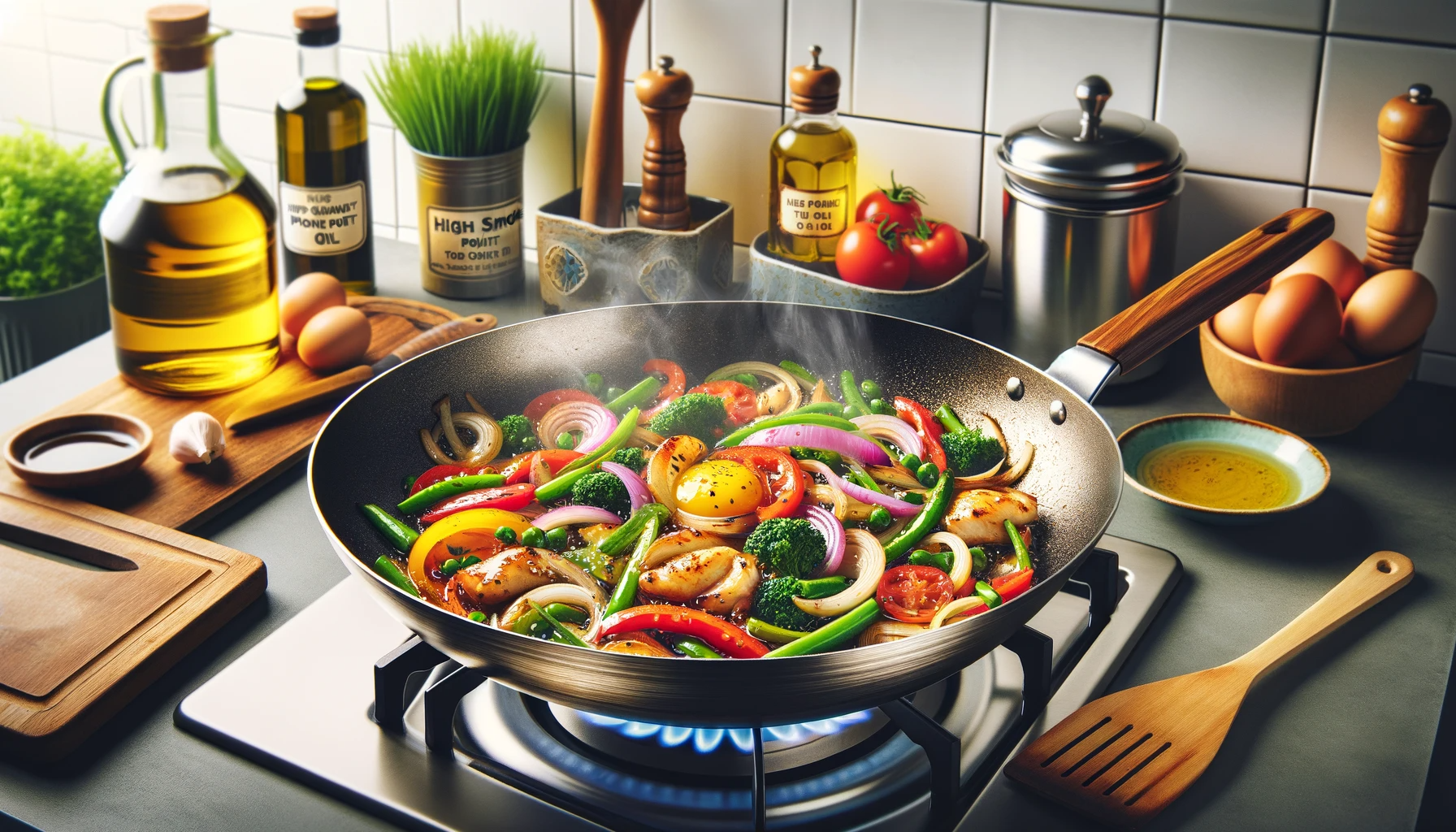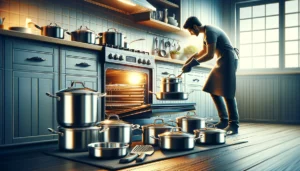Do you dread cooking with stainless steel pans because everything seems to stick, burn, and leave a horrible mess?
Learning tips like seasoning, using the right amount of oil, letting food sear properly before moving, and deglazing can help transform sticky stainless steel into a slick and smooth surface.
Let’s dive into the techniques that allow food to slide right off stainless steel cookware.
How to Prevent Food From Sticking to Your Stainless Steel Cookware

The key to preventing food from sticking to stainless steel cookware is properly preheating with enough oil, allowing a seared crust to form before moving food, using non-abrasive utensils, avoiding moisture buildup, and promptly deglazing and cleaning after cooking.
First, thoroughly grease the pan with butter or oil once hot.
Do not add food right away.
Let the fats shimmer before adding items.
Resist stirring initially so a browned exterior can set.
Scrape food loose with wood or silicone.
Control steam through low heat, ample room, and venting lids.
Deglaze while hot.
Then clean with non-scratch pads.
Following these simple guidelines allows stainless steel pans to become practically non-stick.
Properly Season Your Cookware

It is important to properly season new stainless steel cookware before first use.
Seasoning fills in the microscopic pores of the metal, creating a surface that prevents foods from bonding.
To season a stainless steel pan, rub a thin coat of high smoke point oil – such as grapeseed or avocado oil – all over the inside cooking surface.
Use a paper towel or soft cloth to massage the oil into the metal.
Make sure to get into the edges and corners.
After thoroughly coating, place the pan upside down on the middle rack of an oven preheated to 450°F.
Bake for 1 hour to set and harden the oil.
Then turn off the oven but leave the pan inside as it gradually cools.
This process bonds the oil to create a smooth, non-stick coating.
For optimal non-stick ability going forward, re-season about twice per year.
The steps are the same – wash pan in hot, soapy water, dry thoroughly, coat with fresh oil, and bake upside down at high heat for an hour.
Use the Right Cooking Techniques

Unlike materials like cast iron or ceramic, stainless steel can sometimes be stickier if not used properly.
The smooth surface requires building up enough heat underneath before placing oily foods or sauces into the pan.
Not taking the time to gradually preheat may cause ingredients to cling.
Make sure to heat pans over medium setting for 2-3 minutes before adding any oil or butter.
Increase to desired cooking temperature then allow the fats to shimmer or smoke lightly before adding food.
This opens the steel’s pores so the oil can spread evenly and create a barrier between metal and food.
Be mindful not to overload the pan, as overcrowding with too much food at once generates steam and moisture that makes items sticky.
For less sticking action overall, try to use low or medium low settings whenever possible instead of searing at super high heats.
Use Plenty of Oil or Fat When Cooking

Using adequate amounts of oil or butter when cooking is key for keeping stainless steel non-stick.
Fats create a protective coating over the steel so food simply slips and slides instead of bonding.
Thoroughly grease cooking surfaces with olive oil, avocado oil, coconut oil, ghee, or butter before adding any ingredients.
Use enough to completely cover the bottom and at least halfway up the sides of skillet or saucepan.
For stir fries, about 2 tablespoons of oil is needed for an average sized pan to ensure everything moves freely.
When sautéing vegetables or meats, do not skimp on the butter or quality oils.
Spoon oils over top of food frequently while simmering stews or braising meats.
Adding extra splash of fat here and there guarantees nothing sticks or scorches.
Take care not to cook with little or no oils, as food is almost certain to weld itself to ungreased stainless steel.
Allow Foods to Cook Undisturbed
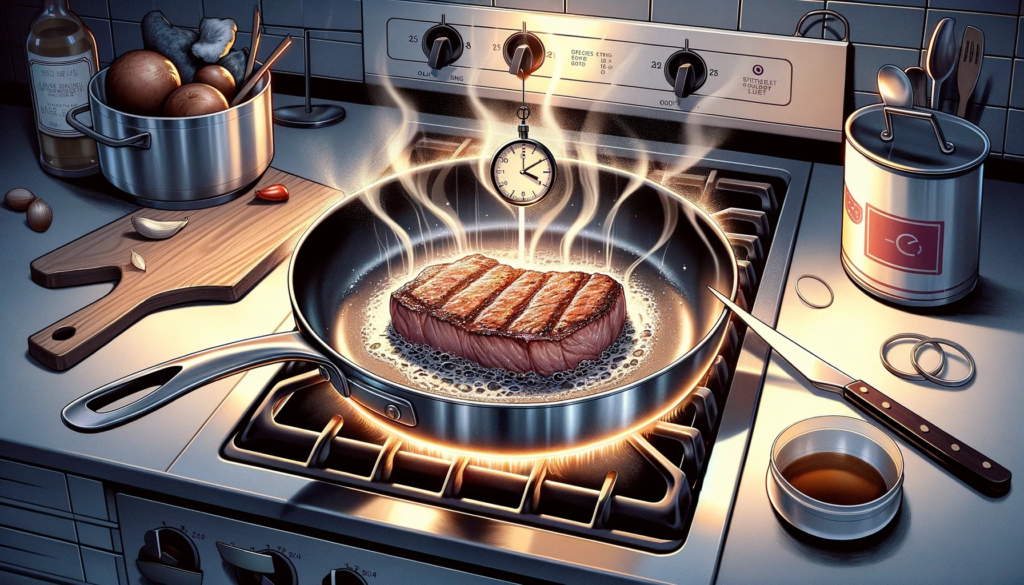
Flipping or turning foods too early is another culprit that causes sticking and stubborn residue.
Allow items like pancakes, burgers, fish fillets, steaks and more to properly sear and develop a browned crust on the first side before nudging.
When placed into a hot, greased pan, moisture is released as the food cooks.
This converts to steam which gets trapped underneath, preventing the surface touching the metal from crisping up too quickly.
If flipped too soon, foods tend to stick from the wetness.
But leaving them alone enables steam to escape so the cooking side dries out, forms a sturdy outer layer, and releases easily when ready.
Use metal spatulas or tongs to loosen pieces that may stick slightly after getting nice color on both sides.
Deglazing the pan afterward also helps release any stuck bits (see next section).
Just be patient and let foods cook undisturbed at least half way through before attempting to dislodge.
Deglaze and Clean Properly After Cooking
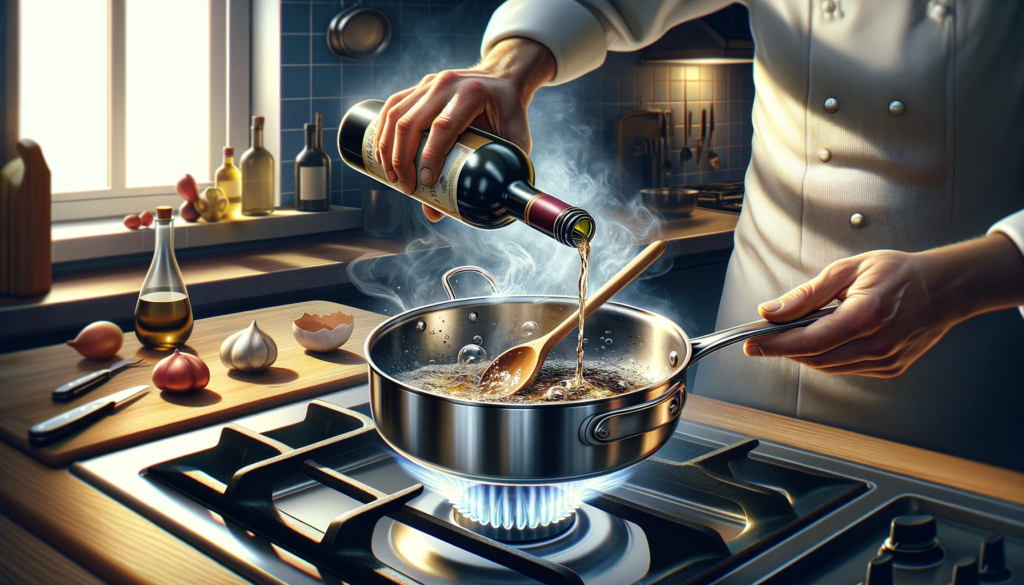
Part of non-stick maintenance is also proper cleaning after dishes are done.
Deglazing means pouring a bit of acidic liquid like wine, vinegar, lemon juice or broth into a hot pan and stirring to dissolve cooked-on bits.
This mini sauce becomes full of meaty or vegetable flavors.
Deglazing helps loosen stubborn stuck-on food residue so scrubbing is easier later.
Always deglaze while the pan is still hot after cooking.
After deglazing, do not let debris dry on all night.
It is much simpler to clean stainless steel pans immediately versus letting messes congeal.
Fill pan with hot water and let soak if very dirty.
Use non-abrasive dish sponges and soft brushes.
Baking soda, Bon Ami powder, or liquid Bar Keepers Friend also remove stuck-on gunk without damaging the finish.
Harsher scrub pads risk scratching the surface which then leads to even worse sticking issues later.
Properly Season Your Cookware
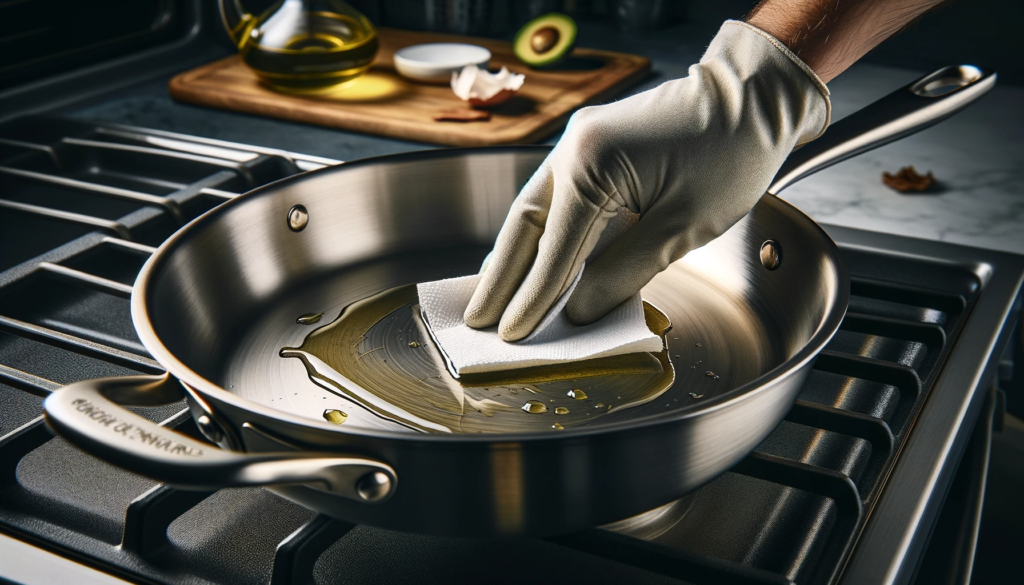
It is important to properly season new stainless steel cookware before first use.
Seasoning fills in the microscopic pores of the metal, creating a surface that prevents foods from bonding.
To season a stainless steel pan, rub a thin coat of high smoke point oil – such as grapeseed or avocado oil – all over the inside cooking surface.
Use a paper towel or soft cloth to massage the oil into the metal.
Make sure to get into the edges and corners.
After thoroughly coating, place the pan upside down on the middle rack of an oven preheated to 450°F.
Bake for 1 hour to set and harden the oil.
Then turn off the oven but leave the pan inside as it gradually cools.
This process bonds the oil to create a smooth, non-stick coating.
For optimal non-stick ability going forward, re-season about twice per year.
The steps are the same – wash pan in hot, soapy water, dry thoroughly, coat with fresh oil, and bake upside down at high heat for an hour.
Use the Right Cooking Techniques

Unlike materials like cast iron or ceramic, stainless steel can sometimes be stickier if not used properly.
The smooth surface requires building up enough heat underneath before placing oily foods or sauces into the pan.
Not taking the time to gradually preheat may cause ingredients to cling.
Make sure to heat pans over medium setting for 2-3 minutes before adding any oil or butter.
Increase to desired cooking temperature then allow the fats to shimmer or smoke lightly before adding food.
This opens the steel’s pores so the oil can spread evenly and create a barrier between metal and food.
Be mindful not to overload the pan, as overcrowding with too much food at once generates steam and moisture that makes items sticky.
For less sticking action overall, try to use low or medium low settings whenever possible instead of searing at super high heats.
Use Plenty of Oil or Fat When Cooking
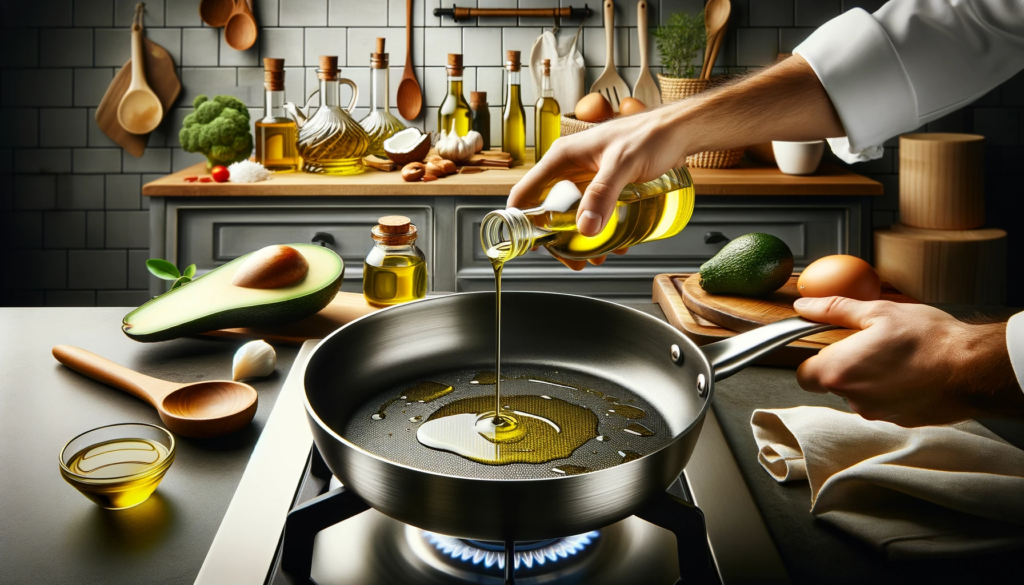
Using adequate amounts of oil or butter when cooking is key for keeping stainless steel non-stick.
Fats create a protective coating over the steel so food simply slips and slides instead of bonding.
Thoroughly grease cooking surfaces with olive oil, avocado oil, coconut oil, ghee, or butter before adding any ingredients.
Use enough to completely cover the bottom and at least halfway up the sides of skillet or saucepan.
For stir fries, about 2 tablespoons of oil is needed for an average sized pan to ensure everything moves freely.
When sautéing vegetables or meats, do not skimp on the butter or quality oils.
Spoon oils over top of food frequently while simmering stews or braising meats.
Adding extra splash of fat here and there guarantees nothing sticks or scorches.
Take care not to cook with little or no oils, as food is almost certain to weld itself to ungreased stainless steel.
Allow Foods to Cook Undisturbed
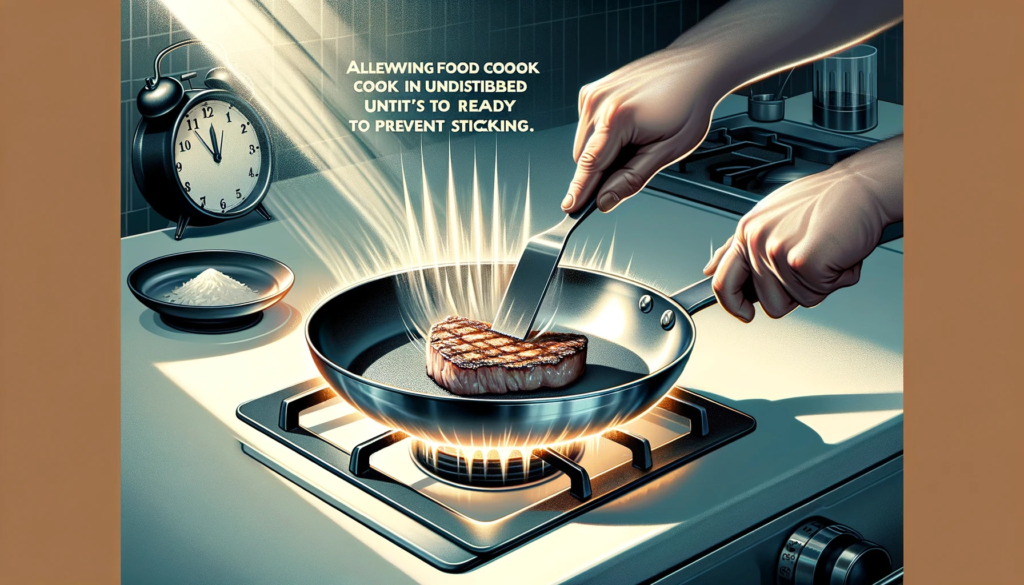
Flipping or turning foods too early is another culprit that causes sticking and stubborn residue.
Allow items like pancakes, burgers, fish fillets, steaks and more to properly sear and develop a browned crust on the first side before nudging.
When placed into a hot, greased pan, moisture is released as the food cooks.
This converts to steam which gets trapped underneath, preventing the surface touching the metal from crisping up too quickly.
If flipped too soon, foods tend to stick from the wetness.
But leaving them alone enables steam to escape so the cooking side dries out, forms a sturdy outer layer, and releases easily when ready.
Use metal spatulas or tongs to loosen pieces that may stick slightly after getting nice color on both sides.
Deglazing the pan afterward also helps release any stuck bits (see next section).
Just be patient and let foods cook undisturbed at least half way through before attempting to dislodge.
Deglaze and Clean Properly After Cooking

Part of non-stick maintenance is also proper cleaning after dishes are done.
Deglazing means pouring a bit of acidic liquid like wine, vinegar, lemon juice or broth into a hot pan and stirring to dissolve cooked-on bits.
This mini sauce becomes full of meaty or vegetable flavors.
Deglazing helps loosen stubborn stuck-on food residue so scrubbing is easier later.
Always deglaze while the pan is still hot after cooking.
After deglazing, do not let debris dry on all night.
It is much simpler to clean stainless steel pans immediately versus letting messes congeal.
Fill pan with hot water and let soak if very dirty.
Use non-abrasive dish sponges and soft brushes.
Baking soda, Bon Ami powder, or liquid Bar Keepers Friend also remove stuck-on gunk without damaging the finish.
Harsher scrub pads risk scratching the surface which then leads to even worse sticking issues later.
Conclusion
Properly seasoning, using good cooking techniques, adding adequate fats, letting food cook undisturbed, and properly cleaning are the keys to preventing food from sticking to your stainless steel cookware.
Following these guidelines will help create an almost non-stick surface so you can cook with ease and enjoy the beauty of stainless steel for years to come.
